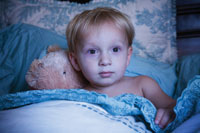They go-go-go all day, so why don’t they sleep all night? If your preschooler has trouble with sleep, you’re not alone. In fact, experts say most kids younger than 6 have some sort of sleep problem; Elizabeth Pantley, well-known author and parenting consultant, puts the number at almost 70 percent.
While preschoolers generally need 12 hours of sleep, “every child is unique,” says Dr. Jeff Ernst of Richmond Pediatrics in Shoreline. He tries to dispel the myth that there is one “normal” sleep pattern. “Parents should watch their children sleep occasionally.  A child who sleeps easily and is restful while sleeping, who seems rested in the morning and does not seem very tired during the day, is probably getting sufficient sleep.”
A child who sleeps easily and is restful while sleeping, who seems rested in the morning and does not seem very tired during the day, is probably getting sufficient sleep.”
If your little one is snoring, waking during the night and having trouble getting back to sleep, sleeping at odd hours, or having difficulty falling asleep at night, he may have a sleep problem. If it seems serious, talk to your pediatrician. Occasionally, sleep problems can be caused by physical problems such as sleep apnea, epilepsy, weight problems, allergies, asthma, headaches, reflux or restless leg syndrome. Treating these problems can help resolve sleep issues.
Patience and persistence
However, more often than not, children’s sleep problems have no physical cause, and parents may find themselves working with their child to resolve such difficulties as an inability to fall or stay asleep, wetting the bed, or experiencing nightmares or night terrors. Many parents use co-sleeping as a solution, allowing the child to climb into bed with them. Children sleep in their parents' room in 79% of cultures worldwide. Yet parents who have used co-sleeping to help their children get a good night’s rest often find themselves desperate to reclaim a private bedroom. When this happens, Pantley suggests a visit from the “Morning Fairy.” “She leaves small prizes outside the bedroom doors of children who stay in their beds all night and don’t wake their parents. She does this for a few weeks, until good habits are in place and then goes off to visit other children who need her help.”
Sometimes a little persistence and patience helps when a child has problems falling asleep. When her son was 3 and couldn’t fall asleep independently, Margaret Certain of Seattle says, “We would leave him for a few minutes at a time and come back to check. He eventually got used to being alone to fall asleep. We assured him that his connection with us was not broken when we left the room.”
A vivid imagination
Bed wetting is a common and usually physiological issue most kids will outgrow. Parents can help by limiting liquids before bed and eliminating caffeine. Preschoolers may feel more comfortable wearing a diaper to bed or sleeping on an absorbent pad until their bodies mature enough to allow them to stay dry.
Vivid nightmares may interrupt a preschooler’s sleep. Parents should calm and reassure the child after a nightmare so she can go back to sleep. But night terrors are very different. “During a night terror,” says Pantley, “your child will wake and let out a scream or fearful cry. Her eyes will likely be opened. She may hyperventilate, thrash around or talk or yell. Actually, your child is sound asleep and in a zone between two sleep cycles.” Pantley recommends a gentle touch, comforting words, leading a roaming child back to bed and keeping the child safe until the terror is over.
The preschooler’s vivid imagination can also improve sleep. Finding imaginative ways to help children feel safe and inspired to cooperate at bedtime can help parents end bedtime battles. Some children may enjoy a chart, poster or homemade bedtime book outlining the bedtime routine. “Magic” can come in the form of sprays (in what appears to be an empty spray bottle) to ward off nightmares or other frights, chants that help children magically fall asleep and sleep all night, or special charms to bring good dreams.
Turn off the TV
Sleep and television make bad bedfellows. Children who watch TV — especially before bed — are more likely to have sleep problems. According to the National Sleep Foundation, a television’s stimulation, noise and light hamper sleep, and its vivid images can lead to nightmares. For these reasons, the American Academy of Pediatrics recommends that a child’s bedroom be a media-free zone — no television, computer or other electronic media allowed.
A leisurely, predictable bedtime ritual is the best way to help preschoolers fall asleep. A quiet house, dim lights, relaxing music, bedtime stories and a gentle massage can all be part of a healthy bedtime routine. In a survey, 97 percent of children told Pantley that they know it’s bedtime because their parents tell them it’s time for bed. “This gives parents more power than they realized,” says Pantley. “They may have never realized that setting a bedtime is as simple as creating a routine around a set bedtime!”
Tera Schreiber values sleep more than she imagined possible before her children were born.
Resources:
- The No-Cry Sleep Solution for Toddlers and Preschoolers, by Elizabeth Pantley
- The National Sleep Foundation
- National Kidney Foundation
Originally published in the March, 2007 print edition of ParentMap.











